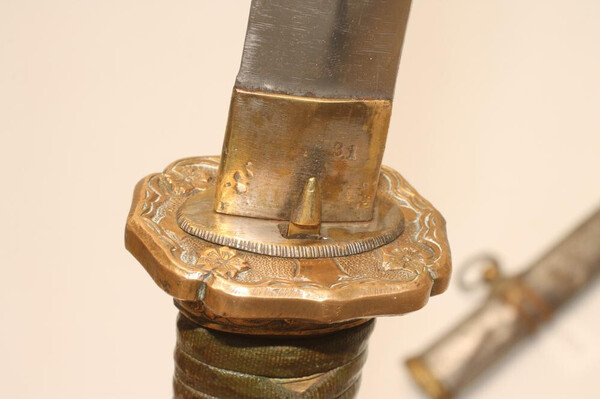-
Posts
2,058 -
Joined
-
Last visited
-
Days Won
11
Everything posted by Kiipu
-
濃州関住服部正廣作 Nōshū Seki-jū Hattori Masahiro saku.
-

Help identifying old family blade in Army mounts
Kiipu replied to Karatedave's topic in Military Swords of Japan
Dave, in addition to the ones Robert pointed out above, read this one. It got buried in the middle of a thread. WW2 Japanese sword Marking -
Several of the images at the link below incorporate tsuba as part of the design. 天照山鍛錬場作 = Tenshōzan Tanrenjō. 光明寺裏山の天照山鍛錬所
-
Ohmura has a picture of a Tenshōzan 天照山 dirk. http://ohmura-study.net/741.html
-
The second picture with habaki number 31 is coming from Hartleys. Alas, the five auction pictures were low resolution. In addition, the link no longer works. But all is not lost Trystan! A mei, a very odd/questionable Nakago, a weird mark and katakana writing.
-
Pictures of 131 can be seen via the link below. I think you have the highest that I have seen so far. Thanks for sharing Nicholas. An Appraisal on Some Japanese Swords Please Sword Number 3
-
Big 名, little 名, and a circle 〇. 名名〇
-

Japanese Sword Blade - 33 1/4" - Translation Needed
Kiipu replied to 7309's topic in Translation Assistance
Cross-Reference Japanese Sword blade - Translation Needed -
Serial 50019 falls within the Suya range. Vitaly, is the scabbard chromed/nickel plated or is it bare metal?
-
Rob, you worry too much! Manual Of How To Handle And Take Care Of Swords
-
If one really whats to get into the minutia of Type 32 & Type 95 swords, look at the end of your sword knot. Now go over to the post below. This was the first thing I noticed when I looked at your pictures yesterday. Tassel Production Kaizen
-
I can faintly see a 東 inspection mark to the right of the serial number. An unserialized scabbard just means it was replaced by a unit armourer at some point. Not as uncommon as you think. As Rob indicated, this is an early aluminium variation with a desirable hilt variation. It is only the fourth one known in the 7,000 range. Oddly, I have serial 7241 recorded, but it was tampered with by "Showa22". Showa22 At It Again! Strongly recommend that you read the entire thread below. It is long winded, but very educational. Short Development History of Type 95 Gunto
-
A rising sun over Mount Fuji 富士山 with clouds or lake to the left?
-
My very own link to "shrinking" pictures. Guaranteed or money back! How to resize a photograph on a Windows computer
-
Vern, to save you some time, the measurements mentioned above are summarized at the link below. And before I run away, nice sword you go there! Sword Blade Measurement Cross-reference to more pictures Old Family Blade in ny Military Mountings
-
Gareth, pics are good enough for government work! The fittings are good quality and would possibility date from 1934 to 1941. There was a blade shortage in the early years, so many older blades got repurposed. If a family blade was available, it got used as well. Looking forward to more of your finds!
-
In actuality, Toyokawa Naval Arsenal 豊川海軍工廠 had nothing to do with swords. They did get involved with rifles, but that was a close as they got. The fable of Toyokawa sword production got started back in the 1980s by F&G. I have studied this arsenal via wartime Japanese language documents and no mention is made of swords. Toyokawa used an entirely different marking method on rifles, machine guns, and ammunition. Markings Used by Toyokawa Naval Arsenal 豊川海軍工廠 = stamped or printed on large items such as machine guns, nameplates, etc. 豊 = large caliber cartridge headstamps. ト = small caliber cartridge headstamps. Toyokawa anchor mark (see picture below). The encircled anchor stamp that is seen on swords is just a generic naval final inspection mark that does not indicate the location of production.
-
A great deal of information about the production of machine made blades can be accessed via Nick's WRF thread below. System Kaizen behind the Type 32 Gunto production of the 1930s
-
Thanks Trystan. Looks like the pronunciation is mamorigatana 守り刀. I see the ceremony is called 賜剣の儀(shiken no gi). 賜剣の儀
-
Does anyone by chance happen to know what the Japanese name is for this "protective dagger?"
-
After the umbilical cord had been cut, the baby was given his first bath. In keeping with the old custom, the water had been drawn from the Kamo River and was mixed with well water. For the next few days, until the baby was given swaddling clothes, he was dressed in an undershirt and a sleeveless coat. His bedding was laid on a katataka (a thick tatami that has been sliced in half on the bias, leaving one end much higher than the other) in the main room of the little house where he was born. A pillow was placed at the high end of the tatami to the east or to the south, and it was guarded by two papier-māché dogs facing each other. Between the two dogs were placed sixteen articles of cosmetics. Behind them was a stand on which the “protective dagger” the prince had received was placed along with an amagatsu doll6 also wrapped in white silk but with red silk pasted to the ends of its arms and its feet. 6. A very simple doll, rather like a modern kokeshi except for the arms, which stick out at right angles from the body, forming a kind of cross. Such dolls were placed beside the bed of an infant to absorb evil influences and thereby protect the child. They were kept by the bed until the child had reached its third year. The doll was about a foot and half tall.
-
Keene, Donald. Emperor of Japan: Meiji and His World, 1852–1912. Columbia University Press, 2002. Chapter 2, Page 11. Before the birth, Nakayama Tadayasu had borrowed safe-delivery charms from various auspicious temples and individuals. He was now able to return them with thanks and presents. A court lady sent by the emperor to inspect the prince left with him a protective dagger and a sleeved coverlet (kaimaki). The baby would receive many other presents that though traditional, may appear bizarre to contemporary readers. First, however, was the ceremony of cutting, binding, and cauterizing the umbilical cord.4 The placenta was washed and placed in an earthenware vessel which, in turn, was placed in a bucket of unpainted wood, wrapped in white silk, and displayed on a stand in the next room along with a pair of knives, two blue stones, and two dried sardines.5 In front of them a lamp was kept burning day and night, and a screen was placed around them. The wooden bucket was decorated with designs in white paste showing pines, bamboos, cranes, and tortoises but not plum blossoms (usually associated with pines and bamboos in artistic compositions) because plum blossoms fall, an inauspicious association. Notes, Page 728 4. Ibid., 1, p. 3. A knife, called a tekōnagatana, normally used in the gembuku ceremony to cut the hair of a boy who has come of age, substituted in the ceremony for the umbilical cord. The authors of the Meiji tennō ki commented that this was probably a remnant of some “old custom.” 5. The sardines were of the kind called gomame, and they were considered to be felicitous because their name includes the word mame, meaning “healthy.”
-

How to resize a photograph on a Windows computer
Kiipu replied to Kiipu's topic in Forum Technical Details and Maintenance
The instructions above also work with Windows 10. If anyone is using Windows 11, can you check and see if the above instructions work or not? Since posting, I did run into one resizing problem. My comments about using 25% worked just fine for images over 2 megabytes (MG). For images under 2 megabytes, start with 50% instead. Any comments, corrections, or criticism welcomed.- 1 reply
-
- 1
-

-

Member total attachment allocation
Kiipu replied to Brian's topic in Forum Technical Details and Maintenance
If using Windows, try this method. It is what I use for resizing. How to resize a photograph on a Windows computer -
It is the words underneath that prompted the rethink. Not sure how a horse is associated with a warrior. Of note, the bottom of WARRIOR is flat while the top is bowed in.












